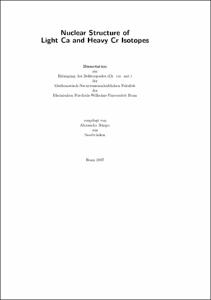Nuclear Structure of Light Ca and Heavy Cr Isotopes

Nuclear Structure of Light Ca and Heavy Cr Isotopes

| dc.contributor.advisor | Hübel, Herbert | |
| dc.contributor.author | Bürger, Alexander | |
| dc.date.accessioned | 2020-04-10T20:24:03Z | |
| dc.date.available | 2020-04-10T20:24:03Z | |
| dc.date.issued | 2007 | |
| dc.identifier.uri | https://hdl.handle.net/20.500.11811/3191 | |
| dc.description.abstract | Although the nuclear shell model was conceived almost 60 years ago, and despite the continuous efforts in experimental and theoretical nuclear physics research, the prediction of nuclear properties is still a challenging task. The study of exotic nuclei far away from the beta stability line is one of the major current research areas in nuclear physics. The investigation of such nuclei becomes possible only gradually with the increasing intensity of the radioactive beams that can be delivered by accelerators. It has become evident that the shell structure of exotic nuclei may be different from that of stable nuclei: new shell closures may appear, or nuclei with magic nucleon numbers may no longer exhibit signs of magicity. The focus of this work was on finding new experimental data in exotic Chromium and Calcium isotopes. In an experiment devoted to the study of the proton-rich nucleus Calcium-36, produced in a knockout reaction from a radioactive Calcium-37 beam, it was possible to obtain data on the ground state and the first excited state of the lightest known even Ca isotope. The measured momentum distributions were analyzed using a Monte-Carlo simulation of the knockout reaction. The experimental results are compared to shell model predictions and found to be largely compatible, although deviations in details become visible. The heavy Chromium isotopes with mass A=56 and A=58 were investigated using high-energy Coulomb excitation of radioactive beams to learn more about a presumed shell closure at N=32 or 34 for exotic nuclei in this region by a measurement of B(E2) values. Prior to this experiment, the assumption of a sub-shell closure was based on systematics of excitation energies of the first excited 2+ states in Cr, Ti, and Ca isotopes. With the new experimental data, a shell closure at N=32 is confirmed for these nuclei, in agreement with other recent experimental work on these and neighboring nuclei. While the experimental evidence has firmly established a sub-shell closure at N=32, calculations are, at present, not able to reproduce the behavior of the B(E2) values, whereas the evolution of excitation energies is well described. | en |
| dc.language.iso | eng | |
| dc.rights | In Copyright | |
| dc.rights.uri | http://rightsstatements.org/vocab/InC/1.0/ | |
| dc.subject | Kernstruktur | |
| dc.subject | exotische Kerne | |
| dc.subject | B(E2)-Werte | |
| dc.subject | Impulsverteilungen | |
| dc.subject | Ca-36 | |
| dc.subject | Ca-56 | |
| dc.subject | Cr-58 | |
| dc.subject | nuclear structure | |
| dc.subject | exotic nuclei | |
| dc.subject | B(E2) values | |
| dc.subject | momentum distributions | |
| dc.subject | Cr-56 | |
| dc.subject.ddc | 530 Physik | |
| dc.title | Nuclear Structure of Light Ca and Heavy Cr Isotopes | |
| dc.type | Dissertation oder Habilitation | |
| dc.publisher.name | Universitäts- und Landesbibliothek Bonn | |
| dc.publisher.location | Bonn | |
| dc.rights.accessRights | openAccess | |
| dc.identifier.urn | https://nbn-resolving.org/urn:nbn:de:hbz:5N-12757 | |
| ulbbn.pubtype | Erstveröffentlichung | |
| ulbbnediss.affiliation.name | Rheinische Friedrich-Wilhelms-Universität Bonn | |
| ulbbnediss.affiliation.location | Bonn | |
| ulbbnediss.thesis.level | Dissertation | |
| ulbbnediss.dissID | 1275 | |
| ulbbnediss.date.accepted | 06.12.2007 | |
| ulbbnediss.institute | Mathematisch-Naturwissenschaftliche Fakultät : Fachgruppe Physik/Astronomie / Helmholtz-Institut für Strahlen- und Kernphysik (HISKP) | |
| ulbbnediss.fakultaet | Mathematisch-Naturwissenschaftliche Fakultät | |
| dc.contributor.coReferee | Thoma, Ulrike |
Dateien zu dieser Ressource
Das Dokument erscheint in:
-
E-Dissertationen (4428)




